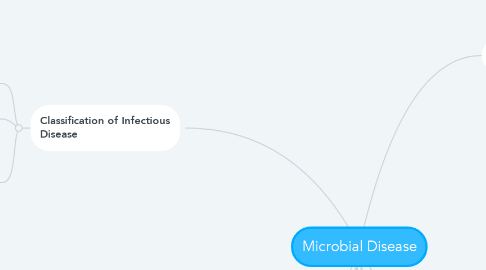
1. Classification of Infectious Disease
1.1. Occurrence of a disease in populations regions
1.1.1. Reported by: Incidence of a disease, Prevalence of a disease
1.1.2. Frequency of occurrence
1.1.2.1. Sporadic (typhoid)
1.1.2.2. Endemic (cold)
1.1.2.3. Epidemic (influenza)
1.1.2.4. Pandemic (occurs worldwide)
1.1.2.5. Epidemic (influenza)
1.2. Severity /duration of a disease
1.2.1. Acute- disease that develops rapidly but lasts only a short time (influenza)
1.2.2. Chronic- disease develops slowly, recur for long periods (TB, hep.B)
1.2.3. Subacute- between acute & chronic
1.2.4. Latent- causative agent inactive for a time then becomes active (shringles, cold sores)
1.3. Extend of host involvement (body part & host resistance)
1.3.1. Local infection
1.3.2. Systemic infection
1.3.3. Primary infection
1.3.4. Secondary infection
2. Development of Disease
2.1. 1. Incubation period
2.2. 2. Prodromal period
2.3. 3. Period of illness
2.4. 4. Period of decline
2.5. 5. Period of convalescence
3. Spread of Infection
3.1. Human body harbor pathogens and transmit them directly / indirectly to others
3.2. Diseased wild & domestic animals transmit to humans (zoonoses)
3.3. Non-living, soil & water
4. Microorganisms enter a Host
4.1. Portals of entry
4.1.1. Mucous membranes
4.1.2. Hair follicles & sweat ducts
4.1.3. Parenteral route
4.2. Adherance
4.2.1. Adhesins/ligands
4.2.2. Biofilms
5. Bacterial Pathogens Damage host cells
5.1. Using the Host
5.2. Direct damage
5.3. Production of toxins
5.3.1. Membrane-distrupting toxins
5.3.2. Superantigens
5.3.3. Endotoxins
5.4. Plasmids, Lysogeny & Pathogenicity
6. Human Microbiome
6.1. Full collections of genes of all microbes
6.2. Most microbes are harmless
6.2.1. Microbes on the human body more than human cells
6.2.2. Normal(resident) microbiota
6.2.3. Transient microbiota
6.2.4. Opportunistic microorganisms
6.3. Normal microbiota-Host relationship
6.3.1. Symbiosis (living together)
6.3.2. Protective role of microbiota
6.3.2.1. Protection against pathogens
6.3.2.2. Pathogens may colonize & cause disease when killed
6.3.2.3. Stimulation of adaptive immune system
6.3.2.4. Stimulation of adaptive immune system
7. Koch's Postulates
7.1. Criteria Robert Koch to establish Bacillus anthracis causes anthrax
7.1.1. 1. Same pathogen must be present in every case of the disease.
7.1.2. 2. Pathogen must be isolated in pure culture.
7.1.3. 3. Same disease must be produced when pure culture is introduced into healthy laboratory animal.
7.1.4. 4. Pathogens must be recovered fro experimentally infected host.
7.2. Some limitations
7.2.1. Some organisms cannot be grown in laboratory medium
7.2.2. Infected individuals do not always have clear-cut symptoms
7.2.3. Some diseases are polymicrobial
7.2.4. Suitable host not always available for testing
8. Transmission of Disease
8.1. Contact transmission
8.1.1. Direct contact
8.1.2. Indirect contact
8.1.3. Droplet transmission
8.2. Vehicle transmission
8.2.1. Waterborne
8.2.2. Foodborne
8.3. Vectors
8.3.1. Mechanical transmission
9. Bacterial Pathogens Penetrate Host Defenses
9.1. Capsules
9.2. Cell wall components
9.3. Antigenic Variation
9.4. Enzymes
9.4.1. Coagulase
9.4.2. Kinases
9.4.3. IgA proteases
